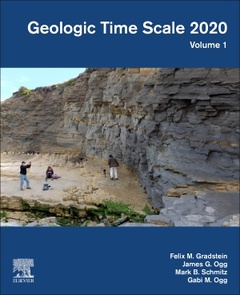Geologic Time Scale 2020 (2nd Ed.) Volume 1
Coordonnateurs : Gradstein F.M., Ogg James G., Schmitz Mark, Ogg Gabi

Geologic Time Scale 2020 contains contributions from leading scientists, with information presented in an easy-to-understand way including numerous color charts, maps, and photographs. Including recent information from such projects as GTSNext, Earth Time Europe, and Chronos, this updated edition explains in detail how and why the time scale is being updated and offers expanded coverage of paleontology and stratigraphy. Twelve mini chapters in Geologic Time Scale 2020 address Evolution and Biostratigraphy in key (micro-) fossil groups. These chapters assist readers of the Geological Period chapters to better understand and appreciate the role played by paleontology in describing and understanding life on Earth in Deep Time.
The authors of Geologic Time Scale 2020 have been at the forefront of chronostratigraphic research and initiatives to create an international geologic time scale for many years, and the charts in this book present the most up-to-date, international chronostratigraphic standard as ratified by the International Commission on Stratigraphy and the International Union of Geological Sciences. As the framework for deciphering the history of our planet Earth, this book is essential for practicing Earth Scientists and academics.
- The most detailed international geologic time scale available that contextualizes information in one reference
- Gives insights in the construction, strengths, and limitations of the geological time scale that greatly enhances its function and its utility
- Aids understanding by combining mathematical and statistical methods to create scaled composites of the global succession of events
- Meets the needs of a range of users at various points in the workflow (researchers extracting linear time from rock records, students recognizing the geologic stage by their content)
- Completely updated time scale including research from projects such as GTSNext, Earth Time Europe, and Chronos
- Addresses Evolution and Biostratigraphy in key (micro-) fossil groups with atlas style range charts which provide detailed explanation of the index fossils and key zonations building the stratigraphic framework of the Geological Periods
PART I INTRODUCTION 1. Introduction 2. Chronostratigraphy: linking time and rock
PART II CONCEPTS AND METHODS 3. Biochronology 4. Cyclostratigraphy and astrochronology 5. The geomagnetic polarity time scale 6. Radiogenic isotopes geochronology 7. Strontium isotope stratigraphy 8. Osmium isotope stratigraphy 9. Sulfur isotope stratigraphy 10. Oxygen isotope stratigraphy 11. Carbon isotope stratigraphy 12. Osmium-Renium Radiogeochronology 13. A Brief History of Plants on Earth 14. Sequence chronostratigraphy 15. Statistical procedures
PART III 16. The Planetary time scale 17. The Precambrian: the Archean and Proterozoic Eons 18. The Cryogenian Period 19. The Ediacaran Period
Both academic and professional geoscientists. Both text and illustrations are directly useful to teachers, and also to practicing geoscientists.
MARK SCHMITZ is Professor of Geochemistry at Boise State University, Idaho, USA, and has extensive research interests in the development and application of radiogenic isotope geochemistry and high-precision U-Pb geochronology to problems of Earth systems evolution. He has been an active member of the Earth Time community and was co-editor and author for the Geologic Time Scale 2012. He seeks to enrich the radioisotopic calibration of the time scale through targeted dating of stratigraphically important volcanic event beds and the construction of robust chronostratigraphic models through geologic time. His extensive database with over 300 standardized radiogenic isotope ages (mainly U/Pb and Ar/Ar) is vital to this book.
GABI OGG applied micropaleontology to Jurassic-Cretaceous correlations before concentrating on public outreach in geosciences. She coordinated the extensive array of graphics in this book, and is the webmaster for the Geologic TimeScale Foundation (https://timescalefoundation.org) and for the TimeScale Creator visualization and database suites (https://timescalecreator.org). In addition to co-authoring
Date de parution : 06-2020
Ouvrage de 1300 p.
19.1x23.5 cm
Disponible chez l'éditeur (délai d'approvisionnement : 14 jours).
Prix indicatif 125,75 €
Ajouter au panier


